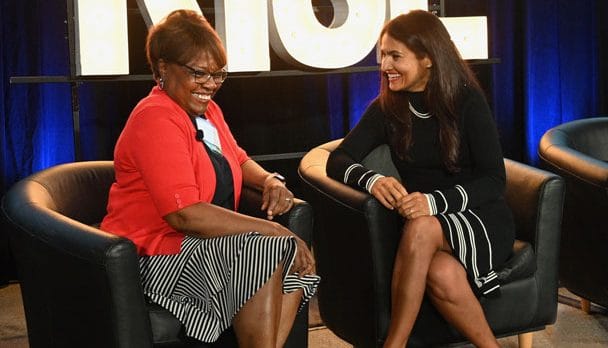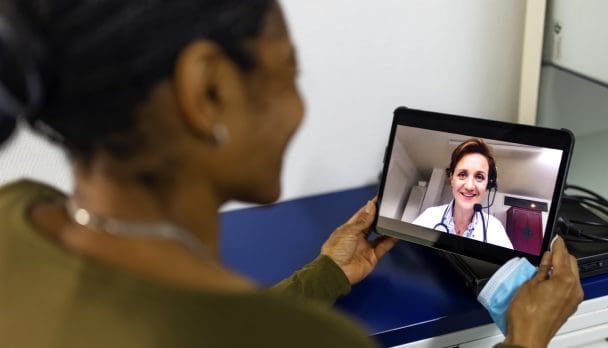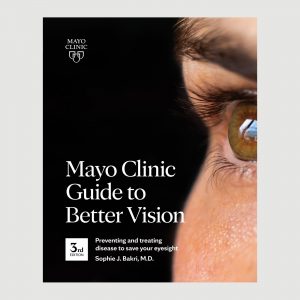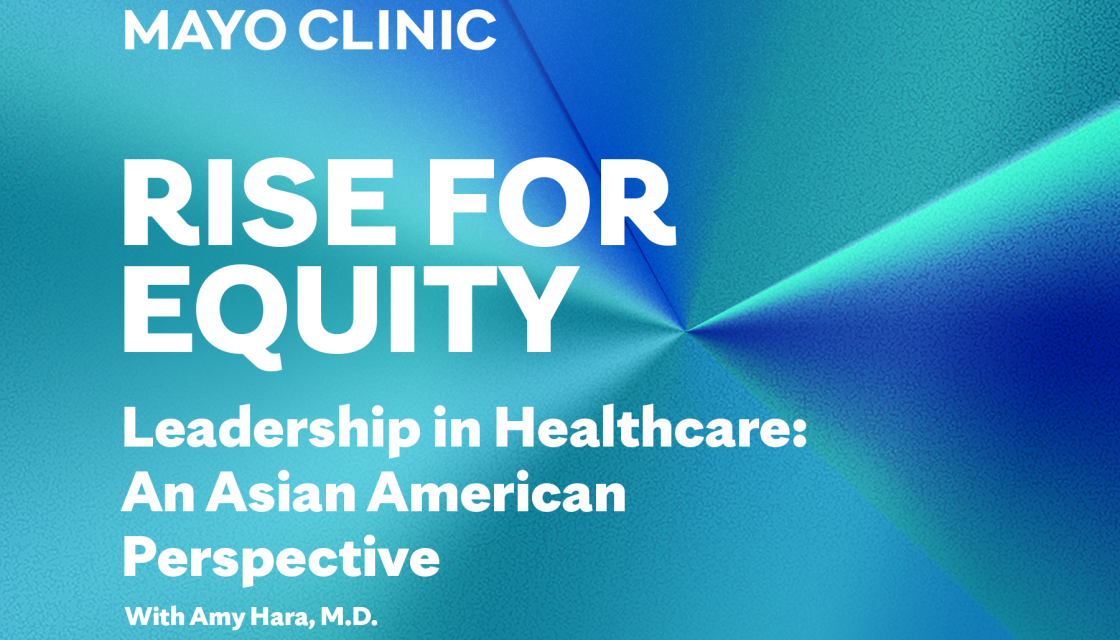
On this episode of the RISE for Equity podcast, Dr. Amy Hara joins host Nicole Nfonoyim-Hara for an insightful discussion on the topic of leadership in healthcare. Dr. Hara, a member of the Mayo Clinic Board of Governors and Mayo Clinic Arizona’s Executive Operations team, shares her experiences and perspectives on what it means to be an effective leader in the ever-evolving healthcare industry.
For my leadership, I really encourage folks to bring themselves. Because you think differently or because you do this differently, you would be a great leader. I try to encourage people that’s a strength in not trying to mold yourself into something else.
Amy Hara, M.D.
Guest:
Amy K. Hara, M.D. is a Professor and former chair of the Department of Radiology at Mayo Clinic in Arizona.
Read the transcript:
Nicole Nfonoyim-Hara: I’m Nicole Nfonoyim-Hara, your host on the RISE for Equity podcast, and today I’m joined by Dr. Amy Hara for an insightful discussion on the topic of leadership in healthcare. Dr. Hara is Department Chair of Radiology at Mayo Clinic, Arizona, and she’ll be sharing her experiences and perspectives on what it means to be an effective leader in an ever-evolving healthcare industry.
Together, we’ll be delving into the challenges and opportunities that healthcare leaders face today. Welcome, Amy. It’s such a pleasure to have you with us today.
Dr. Amy Hara: Thank you. Pleasure to meet you.
Nicole Nfonoyim-Hara: Before we get started, I would love to hear a little bit about your current role with the many different hats that you wear at Mayo Clinic.
Dr. Amy Hara: Thanks, Nicole. This is my last day, coincidentally, of being department chair of radiology at Mayo Clinic in Arizona. It’s a role I’ve held for almost nine years, so it’s the typical eight-year rotation, but it’s super fun. As part of that role, I was also the radiology specialty council chair.
I will continue to serve on the Mayo Clinic Board of Governors, as well as the Arizona Executive Operations Team. I also have a role leading Enterprise Strategic Pricing and have some external roles on some radiology boards. So a lot of different roles. It’s been a very fun journey.
Nicole Nfonoyim-Hara: When you decided to go into medicine, did you imagine yourself taking on all these different types of roles?
Dr. Amy Hara: No, not at all. I have been very fortunate to have people who have encouraged me, given me opportunities, and shown me a future that I couldn’t have imagined myself.
Nicole Nfonoyim-Hara: Why did you decide to go into medicine in the first place?
Dr. Amy Hara: I’m a person who tends to get bored once you reach a certain level of mastery. I wanted to choose a field that would keep me interested and I could never master. And that’s medicine.
Nicole Nfonoyim-Hara: That’s great.
Certainly with all those roles that you have, theres never a dull moment. In terms of your own personal identities, however you define that, how has that influenced your decision to pursue medicine and also these leadership positions that you’re now in?
Dr. Amy Hara: So, there’s always the joke, right? In Asian American cultures, you’ve got three job options which are doctor, lawyer, or engineer. That was certainly prevalent when I was growing up. I don’t come from a family of physicians, although I have folks who are medicine adjacent. My father was a dentist and my uncle was a podiatrist. I think that my dad would have gone into medicine instead of dentistry if the circumstances were different.
I grew up with his interest in medicine which influenced me a lot. Having those examples of other people who were in medicine around us frequently helped to influence where I am today.
Nicole Nfonoyim-Hara: You mentioned being Asian American and the influence of your father.
I think there’s also this kind of overarching narrative around Asian Americans and the model minority. How has that, if in any way, shaped your own experience? Have you experienced that and how have you overcome it?
Dr. Amy Hara: Yeah, so I don’t know that I have all the answers, but I can certainly share my experience.
The model minority, I felt it the most growing up. I’m from St. Louis, Missouri. I grew up there in the 70s/80s, and was one of two Asians in my class growing up. There was a lot of unconscious bias, racism, and teasing. At that time, growing up, all I wanted to do was not be Asian.
I remember that very distinctly. And whenever you try to get out of your box a little bit or act differently, I think that’s where the model minority, you know, the teasing would come up. As I went into college where we had a lot more diversity and certainly at Mayo and in medicine where there’s more diversity the model minority doesn’t seem to rear its head as much.
I would say though, that in terms of Asian Americans and the expectations for me, and when I reflect back on my leadership journey, I think I overcompensated to butt up against it. I was loud about my opinions, standing my ground, and not wanting to be pushed around.
And as I’ve aged, I’ve become more mellow. I think that was a reaction to that.
Nicole Nfonoyim-Hara: Part of the way that you were operating as you were going through your journey. Yeah. You mentioned not wanting to be bored and wanting things to be continuous learning and different every day. In terms of your specific field of interest in radiology, how or what brought you to that? And does your identity play a role in the work that you do on a day to day basis?
Dr. Amy Hara: How did I become a radiologist? When I think back about that, I love those Where’s Waldo books. I think from an early age, I was always looking for something in those pictures. I was a visual person like that.
Also just being an introvert naturally, it tends to be a more introverted specialty. It really suited my personality at the time. So if I’m thinking with my Asian American hat, I do think that radiology as a specialty is for the introvert. It’s for the thinker. It’s a little bit more quiet. It’s more in the background, and I do think that sometimes fits. As in general, we grew up being more quiet and in the background.
So when I think about, does that align? I’ve never really thought about it before. I can see the connections between that and choosing this type of specialty and really liking to be more part of the team than being the person in front. That’s what radiology is. We’re part of many, many teams.
Nicole Nfonoyim-Hara: As a fellow introvert, I’m always fascinated by leaders, right?
Introverted leaders and this idea of quiet leadership. What sort of reflections do you have around the role of people that thrive in the background? For example, maybe a little bit more introverted, sort of have that quote-unquote quiet leadership and are in these roles where they have to make decisions and they have to lead.
Dr. Amy Hara: Right. For my journey, and I love that book Quiet, I think it really helps show that there can be different leadership models because a lot of when I was first starting here, I mean I’ve been at Mayo Arizona for 20 years. The types of leaders that we saw both inside and outside health care were these firm, extroverted folks.
And I never really could identify with that. I was really avoiding leadership, I think, for a long time, like, that’s not for me. I’m happy to be a team player. And in the background, I don’t need that. However, I do think as a society, we’ve evolved and we have a lot of leaders inside and outside health care that are not that kind of stereotypical in-your-face leader.
And so seeing those examples helped me, and what I realized as an introvert and how I try to put in my leadership as well is that it took a lot of encouragement from other people to say, you can do this. You would be great. I just couldn’t see it at all. And so I try to do that for folks too. There’s a body of people that say, well, people should step up to these leadership roles.
Like, we’re not going to reach out and ask them to do it because we want them to do it themselves. And my opinion has always been, man, I needed a lot of encouragement. And so I’m not hesitant to reach out to people and say, you could do this and to think about it.
Nicole Nfonoyim-Hara: That Encouragement and empowerment being a really important piece.
And I like this idea too, of being able to see it. If you can’t see it, then you can’t believe you can actually do it. In terms of your roles at Mayo Clinic Arizona, how did you first move into this leadership role? Was there a specific turning point or specific opportunity that you were like, yes, I’m going to go and I’m going to do this?
Dr. Amy Hara: Sure. I was fortunate that my mentor from Mayo Clinic Rochester when I was a resident came here to be our department chair. That’s Dr. Dan Johnson. He was the chair before I became chair.
We had worked together in Rochester and had a good relationship and he was always saying you can do X, Y, Z. He’s pushed me in multiple different directions. And so soon, even after he started and we know we’re on these eight to 10-year transitions with these leadership roles. My name was put forward.
There was a lead program at that time where you got exposed to many leaders. They talked about opportunities and the hard parts of it. You got a lot of leadership training. I had my first leadership coach then. That was sometime after I had started, but I started to develop the tools and I realized that the reason I was so hesitant was I just didn’t have the tools to handle conflict or to negotiate. All those things can be learned. Once I started to learn them, then I felt more confident that I could do it. So when this leadership role for department chair came up, I wasn’t afraid of it.
I spent seven years preparing in the case that that was going to happen.
Nicole Nfonoyim-Hara: Great. Now I’m hearing a second thing. So there’s empowerment and then there’s the tools that we need. And in terms of thinking about the field of health care, are there certain things? That, maybe you look for, you think about when thinking about what it means to be a leader in health care.
There’s certain qualities that make a strong leader.
Dr. Amy Hara: Yeah, there’s not a single phenotype. There are so many different types of leaders. I thought about that a lot because you try on some different coats when you become a leader, like I should be like this, or I should be like that, and it feels very foreign.
And I think what the most important thing I’ve read in a lot of books, is it’s about authenticity because when you can bring your true self. To work and you know, those two parts are aligned, people feel it. It’s hard to pretend to be authentic or a leader. So that was a really big point that one of the coaches said, they asked me if I put on a suit of armor emotionally when I come to work, because I did. I felt it was exhausting. Because I was wearing this thing, I take it off at home and became a different person. Once I kind of put those two cells together, it became a lot easier. I think the most important thing for a leader is trying to find what your true voice is where you come as a leader.
And to be flexible, continue to learn, and be curious and invite other voices in. Those are the main things I think that I’ve seen is consistent across good leaders.
Nicole Nfonoyim-Hara: I find it really interesting this idea of a suit of armor, which also makes me think of the question, can you as a leader bring your full self?
What does that actually look like? And what does that mean? Especially on top of that, you’re sort of navigating intersecting social identities. How do you feel about that? I mean, do you feel like at this point, you’re now able to bring yourself authentically to the leadership table?
And what are some of the things that have made you feel confident in doing that?
Dr. Amy Hara: First, I do think that every decade I gained confidence. When I was 40, I was a lot more comfortable at saying what I thought then when I was 30. And in my 50’s, now I’m really comfortable. There is a confidence that grows as you’re at these tables and you say something and people aren’t giving you looks, or you don’t have a whole story and narrative going on in your head.
You grow that confidence over time. For me, it was getting feedback and not letting the stories in my head control what I thought was going on. Again, another great thing from coaches, because I would say — someone said this thing, or they looked at me like this, or this email. And they really encouraged me to verify.
So if you felt like somebody was reacting to whatever you said in a certain way, to feel comfortable and ask them — was there something I said? And a lot of times it was all smoke. It was just in my head. And so puncturing all those, balloon stories over your head. That was what was really helpful for me.
Nicole Nfonoyim-Hara: That image of puncturing the balloon stories. I think we could all use that. In terms of your leadership journey, did you see models for yourself and people who were in leadership positions? And then if you didn’t, now that you’re sort of in a leadership position yourself, is there part of the ways in which that you lead and mentor?
It’s that part of it to be able to offer a model to people that are coming up behind you.
Dr. Amy Hara: Female role models were hard to come by because I think that in the generation of female leaders before me, they had to develop a pretty strong suit of armor to make it to that level.
And so you didn’t see a lot of the vulnerability. It was a harder type of thing. There was also, at that time, one seat at the table for the fame, so there was a little bit of that, which made it harder. That was discouraging. I remember thinking, I don’t see anybody who I thought was like me at these tables.
And I did, you know, eventually realize that I was kind of different or in all the good ways of diverse thought. That we see in a lot of other people and that’s why I was being invited. So it’s a switch to think you’re supposed to be like this person to be at the table. It’s actually the diversity that could get you invited to the table.
For my leadership, I really encourage folks to bring themselves like, it’s because you think differently or because you do this differently. That you would be a great leader. You know, look differently. You were brought up differently. However it is, I try to encourage people that’s a strength and not trying to mold yourself into something else.
Nicole Nfonoyim-Hara: That’s what I think, that this idea of being the only one at the table or being maybe the first one at the table, and that being sort of a superpower in its own way. We hear from leaders from marginalized communities that are often reporting this feeling of the minority tax. For example, and especially in healthcare, when you’re a clinician and you’re doing that.
And then you’re also wearing all these different hats that sometimes ask for extra labor to either represent a group or advanced equity initiatives, and sometimes at the risk of your own professional advancement. Is this something that has resonated with your own experience or have you seen it in others?
And how can we support leaders who are feeling that tax or afraid of stepping into leadership positions because of that?
Dr. Amy Hara: Right, thank you. I do want to focus on the question that you asked earlier, which is bringing your true self to the table. And I’m not going to downplay the difficulty in all the running narrative, that’s going on at all of these meetings. You really have to decide, am I going to say that there’s a lot of that because let’s not lie. I mean, it’s political. You can’t come in there like a bull in a china shop every time.
I think we’re all trying to find out, especially when you have leadership changes. I think about all the people in my department, they’re all trying to figure out, with the next leader, how does this person work and things like that. We’re all constantly navigating that change.
Nicole Nfonoyim-Hara: Thank you for reflecting on that. And about this idea of the minority tax. So we want to be at the table. We’re often the only ones at the table. Then what does that mean for the burden that we have and how to help people?
Because I think studies have shown, and there’s these anecdotes around minority leaders feeling like they’re burdened, and should I be taking on these leadership roles if maybe it’s going to keep me from advancing professionally?
Dr. Amy Hara: Yes, I don’t think I’ve been a great model for that and was more ignorant going through my leadership journey.
I didn’t take on the diversity roles or try to be a spokesperson for female leaders, or, Asian leaders, etc. I think it’s like the chihuahua complex. I didn’t see myself as that when I was around the table. So it didn’t draw me to it. And I do think that we had so much excellent work done by Anita Meyer at Arizona and her team about these unconscious bias.
And she was a great mentor to me in Arizona. And when she published that study about introductions and how female physicians were often introduced by their first name and male physicians by doctor. I just started noticing it everywhere. It happened to me once at a ceremony and she was in the audience and she said, did you see that? Notice that? I’m like, no, I didn’t notice.
I mean you don’t know it. I think my eyes are more wide open now. I would say that. When I got some of these leadership roles, there was this undercurrent of, oh, of course, she got it because she’s female. Of course, you got it because you’re a minority.
And there’s some of that chatter and that goes on in people’s heads. When I’m trying to bring people up, they’re like, are they just asking me because I’m female or because I’m this or I’m that? And my response has always been, well, who knows, maybe, but just show them you can do it and then that’s that.
I don’t spend a lot of time in that space of thinking, how did I get here? It’s more, now that I’m here, what can I do to bring others with me? And how can I represent well?
Nicole Nfonoyim-Hara: Focusing on that, how have you brought others into the leadership space? And then also in terms of your day-to-day, what does that look like? You know, juggling all of that in a leadership role.
Dr. Amy Hara: Sure. So in terms of bringing other people, I do think that over my last nine years, we’ve recruited a lot of women.
We’ve recruited a lot of Asian women in particular. And I think there is something they see in me doing that. It helps them feel comfortable in making a move from another institution, that there are these opportunities. I’m enjoying myself and I can do it and I don’t feel like I’m being dragged down or dumped on.
I do think that helps and I only have my leadership journey, which I reflect on. I’ve seen a lot of others, but I try to give the tools as a leader that helped me the most. That’s access to leadership coaching. I encourage it for all of our leaders. Actually, some think that you only go into coaching if you’ve got a problem.
But I would say that its about developing tools in your toolbox. And the more tools that you have, the more comfortable you’re going to feel taking on these roles and navigating the space. So as a leader, I know that I have really tried to provide that access as much as possible and also sharing all of the difficulties.
I’ve had the mistakes that I’ve made. This is not a job for someone who seeks perfection. So I think being real and about what this job really is, and all the things that go on in your head and the other advice I give for leaders or aspiring leaders is that you can go into it thinking that this is an opportunity to highlight all your strengths.
But I say there’s an equal spotlight on all of your weaknesses. So while your strengths are going to be amplified in this role, so are your weaknesses. And it’s really about, I learned probably more about myself, I feel, than I’ve taught other people, because it’s like everything gets magnified in that space.
The day-to-day, I do clinical work either one or two days a week and still take call and all of that, and in my administrative roles usually anywhere from three to four days travel to Rochester every month. Yeah, there’s a lot of flipping. I’m a clinician. I’m also a member of my division, but also the department chair and what I didn’t realize when I first took on this role, because I had been here for you know, 15 years before I became department chair.
I thought, well, we’re all just, here I am. The next day things flipped for everybody except for me. And I was still going around as being my regular self, but not realizing people are acting differently. People, you need to reset as a leader. It’s a whole different relationship.
I think I’m more cognizant now of my presence and when I say things, but I still make mistakes. Sometimes you’re just you and you forget you’re also in the department chair hat, wherever you go.
Nicole Nfonoyim-Hara: Its really interesting that the next day you were the same person, but everyone had changed around you.
And the consciousness that it takes to sort of say, well, now the relationship is different in the way that I moved through this role. And then also that it’s this idea of perfection, right? I think we put leaders up on a pedestal, obviously, and when we’re thinking about leaders and becoming a leader, we think everything has to be perfect.
And you said rightly so, that it’s not actually about that at all. And I’ll put a little spotlight on you to share a little bit about when you talk about these challenges and mistakes. Can you talk a little bit about some of the ones as you think back that in your early sort of like, we’re sort of coming into leadership. What were some of those?
Dr. Amy Hara: Oh, so many. I just did a whole podcast with several other leaders for the learners here at Mayo, where we talked about failure and all the mistakes we made, and it was very cathartic for all of us. They’re fresh of mind. To that point of everything changed a little bit for everybody else. The day I became chair, but not for me. I had so many ideas. I was so excited to finally get my hands in there and do stuff but there’s way too much going on and people are trying to help you be successful. But that was a lot of the mistake.
Just jumping in there and thinking I had all the answers was a big starter mistake. What I realized in my leadership style, in the first two years. Was that I was not getting honest feedback because I was bull in a china shop. I thought I had it all figured out.
I also didn’t want to ask many people to do things for me because I thought I was doing them a favor by doing their job or making their job easier. And basically people just felt like she’s just going to do it on her own until I hit a wall with that and finally got some feedback.
I was really fortunate Wyatt Decker was a CEO at that time and walked me through like, you need your team and you need to let your team do stuff. You need to be honest with your team about the struggles that you’re having and all this other type of stuff. I felt like we were able to really start anew and go, but so many mistakes in that way.
Nicole Nfonoyim-Hara: I only call them starter mistakes when it’s sort of learning by doing and then you can work your way through it and wonderfully, in your case, you were able to get mentorship and some sort of feedback. About your lack of feedback. In my previous roles at Mayo, I worked with learners and the importance of talking to learners about those failures. Cause again, this idea that everything needs to be perfect. I have to have all the ducks in a row. And there’s no room for error. It’s not even so much that there’s room for failure. It’s that failure may actually be necessary for your own growth and in your own journey.
Dr. Amy Hara: I encourage people that it’s the step that you take after you fall down which is the most important step because there is not a leader that hasn’t had a big misstep or mistake. And what everyone’s watching for is how do you react after that? Not the mistake itself, but it’s what did you learn from it?
Did you reflect on it? Are you still doing the same thing? I mean, those are the things that leaders are evaluating other people on.
Nicole Nfonoyim-Hara: We’ve talked about having different identities and being in these high-level leadership roles. What impact does having more representation of these marginalized voices and high-level leadership have on the patients that we serve and equity outcomes as a whole?
Dr. Amy Hara: I mean, study after study has shown that having diverse voices around the table leads to better and probably more equitable decisions. I’ve certainly seen that in play. If you don’t know what that experience is like, it’s hard to speak to it. And particularly in healthcare, there are cultural differences.
Something that may work for one group will not work at all for another group. That could be based on culture or age or anything like that. I think when we talk about where we want to go as a health care institution finding solutions that we’re putting in place for others. It’s not a one size fits all in anything.
Having more voices say, that might work over here, but it’s not gonna work for there. That can work in the city, but not in rural and a lot of that is around, you know, access and telemedicine. Do people have access to be able to have a computer and all those types of things? I do think we don’t ask a lot about Asian Americans, but Asians in general are very private.
I think about that and the impact on health care and how one approach, in some ways, may be more comfortable with a digital interface where they can be honest about, you know, they’re smoking too much or drinking too much or not exercising than they are with a face to face interaction.
It’s completely opposite for other groups or other people. I do think that having more experiences around the table helps us to come to better decisions.
Nicole Nfonoyim-Hara: It’s just different perspectives too. And you are able to see, I imagine, things that other people can’t see. So then that can be brought to the table as well.
We’ve been talking a little bit about Asian Americans and while statistically, overrepresented in the field of as physicians in the field of medicine, Asian Americans in medicine are actually largely left out of high level leadership. What are some of the reasons for that, that you know of and the barriers to that?
Dr. Amy Hara: Well, I will reflect on my own upbringing, so Japanese American, and in my house, it was to be humble. Don’t brag. You don’t really want to say anything that’s too controversial, trying to make everyone comfortable and generally just holding it in. I think that a lot of us grow up with that and it even, and for me too, it’s hard to say what you really think. To not be thinking about the other person and how their reaction and their feeling, which we always should do.
I do think the way that I was brought up and in a lot of Asian cultures, that is a barrier because you do need to say your voice and say your opinions at that table. And I was lucky again, I had a lot of encouragement for people when I got on some of these leadership opportunities as you’re here because we want to hear your voice.
It is not helpful for you not to say your voice. That’s one thing. I think the other thing is, many of us, and I don’t think this is just Asians, but Asians have a hard time bragging and self promoting. And that’s not the way to get leadership positions, but there is an art to not being shy about saying what you can do or how you contributed to this project without flying all your flags and not paying attention to others.
Those two things, I think are hard for Asian folks and also the conflict. Because again, in our families, many didn’t address conflict. And leadership positions are a lot about managing conflict. That is definitely the tool I had to work on the most and continue to work on in leadership roles to be effective.
One of the things as an Asian American leader that I really had to get over from my upbringing was the expectation in our house was, you’re going to go to school and of course you’re going to do well at school and we will not overly acknowledge these accomplishments because that’s the expectation.
And what I realized when I became a leader is that encouragement costs nothing. It wasn’t in my nature to say, great job at this because I expected that, of course, you were going to do a good job. That was a cultural thing that I realized that I needed to be. Much more encouraging and much more of a cheerleader than I grew up with or had seen.
Nicole Nfonoyim-Hara: In terms of thinking about the future and what’s on the horizon in terms of leadership in the health care industry? What are leaders doing now to increase equity across the health care industry? And what is your vision? For that more equitable future when it comes to leadership?
Dr. Amy Hara: Well, I think what’s been really encouraging over my 20 years at Mayo is to see the tolerance and interest in having different voices around the table. I do think that where it is going and where we see outside of health care, you look at who heads Google and Microsoft. These are different types of leaders.
So we’ve seen a lot of different phenotypes of leaders and different ways that things can work. I’m encouraged by that. That there will be all different types of folks at the table. And in terms of increasing the equity of leadership, I do think that there is purposeful efforts to encourage diverse individuals to apply for these top leadership positions.
What I would hope and improve, and again, this is inside and outside health care, is that when these less represented groups, whether it’s a woman or other, fail or stumble, it does seem like the rope is cut off quicker than if it’s not an underrepresented group. That’s where I think we can really improve, to realize everybody stumbles, and it’s not so magnified because there’s just four people in this group, but there’s a hundred people in this group. They do the same thing, but it’s so amplified because it’s just these few. I know personally, I’ve had to talk to myself because sometimes you see women and when they fail, you think, Oh, why? You know? And I don’t have that same reaction with men because that’s happening kind of all the time and it doesn’t affect me the same way.
And I’ve got to get over that. They’re not representing all women. We’re all just trying to do our best.
Nicole Nfonoyim-Hara: Sure. Yeah, there is a double standard when it comes to being a leader, in these groups.
And so the expectation and the magnifying glass is certainly more amplified, as you said, as we’re wrapping up here, you’ve shared so much about your own personal experience and journey and the things that you’ve learned along the way. What advice would you share for those who are listening in and are interested in becoming a leader in the healthcare industry?
Dr. Amy Hara: Well, my advice would be stay curious. Stay humble, look at yourself before you blame others. That has been my big leadership lesson. That you can spend a lot of time pointing fingers, but the consistent thing in most of these equations is yourself. You’re in there. I think the more you work on yourself and your ability to navigate really tough things is what helps you become a better leader.
So I always just say, reflect it back on yourself. I would get rid of perfectionism as the goal, and sometimes it’s just moving the needle. As I’m transferring out of this department chair role, there’s a lot of things we accomplished, but a lot of things we didn’t. A lot of things that are in transition.
And that’s the great thing about Mayo, I think, is this baton passing. Where you’re not going to tie everything up in a bow. There are things that take longer, things that aren’t going to be successful this time, but maybe they will next year or in the next five years. And you just have to keep moving forward and not focus on all the things that didn’t happen or get too fixated on that.
My other advice that I give folks is you have to be kinder to yourself. I think our internal voices are our hardest voices, and I’ve worked a lot on letting things pass by, that talk didn’t go as well. Maybe this podcast didn’t go as well as I would have liked, you know what I mean? But, I did my best and now I’ve got to focus on the next thing.
So having a less short term memory, I think in a way is letting those things go and not perseverating on it helps you keep moving forward. And that’s really the whole goal. Let’s keep moving.
Nicole Nfonoyim-Hara: Well, this podcast was excellent. And for your perspective and joining us today, you know, and I think what has been a really candid conversation about your own journey and some of the things that really does take to kind of take on a leadership role.
And I think some of the things that have stuck with me from what you’ve talked about have been, when you’re thinking about becoming a leader, the types of things that you need, you need that empowerment and encouragement, you need some tools, you need support and that support needs to sort of wrap around an individual to be able to sustain them through, and then the personal part of it.
You mentioned how leadership was. Its it’s own set of sort of personal growth journey and so there’s going to be mistakes and there’s going to be failures and that’s all part of the process as well. I thank you so much for sharing that with us as well as some of the real barriers that are facing leaders from different communities and particular underrepresented groups as well.
We appreciate your leadership and your story, Dr. Hara, and for sharing with us what it’s going to take to move us forward.
Dr. Amy Hara: Thanks a lot. Thank you, Nicole. I appreciate it.
Nicole Nfonoyim-Hara: Dr. Hara, we so appreciate your leadership and the story that you’ve shared with us about what it’ll take to move us forward.
And that’s all for today’s episode of the Rise for Equity podcast by Mayo Clinic. I am your host, Nicole Nfonoyim-Hara, and we hope you’ll join us for our next episode. We’ll see you then.
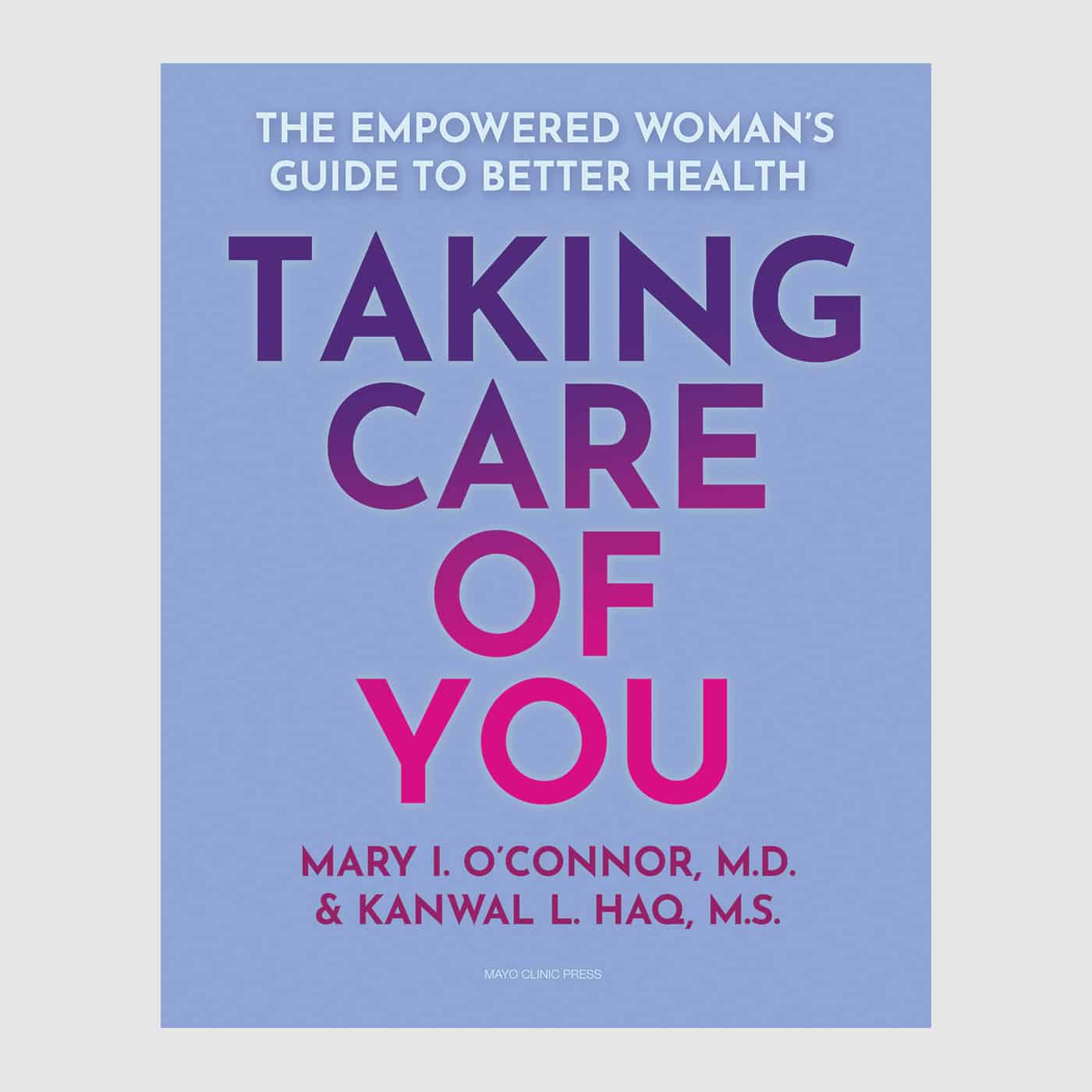
Relevant reading
Taking Care of You
A practical and extensive resource guide for women who want to understand and take charge of their own health and healthcare, presented in short, focused, easy-to-read chapters.

